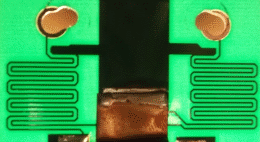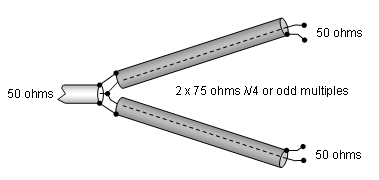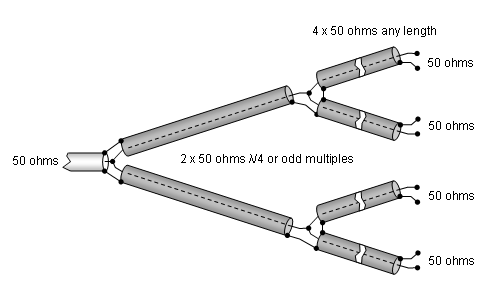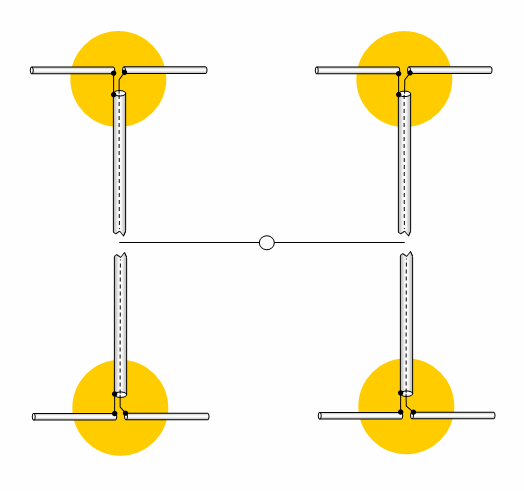Coax Transformers[转载]

How to determine the needed Z for a wanted Quarter Wave Lines tranformation ratio

Some applied examples
1. From 50 ohms feedline to 12.5 ohms Yagi with straight split DE?
Z = sqrt ( 50 ohms x 12.5 ohms) = 25 ohms
This we can produce by using two 50 ohms Quarter Wave Lines in parallel
2. From 50 ohms feedline to 28 ohms Yagi with straight split DE?
Z = sqrt ( 50 ohms x 28 ohms) = 37.4 ohms
This we nearly can produce by using two 75 ohms Quarter Wave Lines in parallel
3. And finally the trivial case:
From 50 ohms feedline to 50 ohms Yagi with straight split DE?
Z = sqrt ( 50 ohms x 50 ohms) = 50 ohms
How to transform from 50 ohms to 12.5 ohms using parallel Quarter Wave Lines

How to transform from 50 ohms to 28 ohms using parallel Quarter Wave Lines (aka DK7ZB - Match)

How to transform from 50 ohms to 200 ohms using parallel Quarter Wave Lines // corrected 2014-09-23, tnx DH1LM,
who showed me that the old sketch was wrong. Hopefully this one does ...

Using Quarter Wave Lines this way works as a series collection actually, Z is 100 ohms, Za = 50 ohms, Zb = 200 ohms
How to transform from 50 ohms to 75 ohms using parallel Twelfth Wave Lines

How produce Ferrite RF Transformers for various impedances transformation ratios
• Ferrite Transformer
Image shows a 1:1 transformer as blue and black wires windings
ratio is 1:1. This one is for Shortwave use. For VHF / UHF dimensions must be much smaller.

Windings N1/N2 ratio by square is transformation ratio for impedance:
Example: Za = 50 ohms, Zb = 200 ohms ...
Na = 6 wdg; Nb = 12 wdg => Na/Nb = 6/12 = 0.5
Transformation ratio = (Na/Nb)xy2 = 0.25 = 1/4 or 1:4
200 ohms x 0.25 = 50 ohms
• Balun Transformer

The Balun transformer is a two-in-one device:
The transformation ratio is same as described above, but now the 50 ohms side is unbalanced (coax feed)
while the 200 ohms side is balanced or symmetrical.
An often seeked for transformation ratio might be 50 to 75 ohms.
This could be acheived using 6 and 9 wdg. respectively 6 + 3 wdg on the Balun Transformer.
• What about the size of the ferrite then?
For any receiving purpose it may be very small. Same to the wire diameters. A tiny ferrite bead equipped with 0.12 mm or so enameled copper wire will do for most purposes. For handling transmitting power or limits issuing intermodulation there is one rule: The ferrite must not saturate. Big is beautiful and size does matter here. Unlike with applications for short wave where ferrite baluns in transmitting antennas are widely used we have only few data and less working ferrite materials when we talk VHF / UHF applications. A rule of thumbs is .. it must not heat up much, it shall not get hot of very warm during transmitting. Having large size ferrites and wires wrapped around is in contradiction to the need for shortest wires on VHF / UHF. That is why we find receiving purpose small ferrite bead based transformers often, but power handling transmitting transformer very seldom here.
Real dimensions: using very small double hole ferrites in a 144 MHz RX frontend

they do not need to be as tiny as that, but to give an impression ...

However here is a little table holding some suitable types, makes and sizes for VHF / UHF transmitting purpose ferrite transformers
Size Amidon T37 or T50, inner diam. = 5.21 / 7.70 mm fit RG58 and RG142 B/U Teflon coax.
Size Amidon T80, inner diam. = 12.60 mm fits RG213 coax, Aircell ...
Code T50-0 (color code: brown) covers 50-300 MHz
Material 43 is for blocking VHF/UHF frequencies
A good choice are the following cores:
FT 50 B-43 inner diam. 7.9 mm, outer diam 12.7 mm, length 12.7 mm (approx EUR 3 pp.)
FB-43-5621 inner diam. 6.4 mm, outer diam. 14.3 mm, length 28.6 mm
FB 43-1020 inner diam. 12.7 mm, outer diam. 25.4 mm, length 28.2 mm
![]()
A commerially made broad band Transformer to match 75 ohms feedline coax to a 300 ohms UHF TV antenna
PCB with inductances.
Designing something like this is rather complex and usually done using an 'EM' software like Sonnet EM, FEKO, ADS ... . So I just show an example. For those who want to dig themselfs into the topic: There are free, limited in size of analysed object versions like 'Sonnet EM Lite' available.

For an etched on PCB solution for 70 cm Amateur Radio Band that does 50 to 28 ohms see here ![]()
![]()
How to transform from 50 ohms to 200 ohms to feed a Folded Dipole as Driven Element

The transformation ratio of a Half Wave "Diversion" Line is 1:4.
What to avoid feeding a Folded DE

Do not attach the feeding coax in a way as shown above so that the coax loop forms anything close to Quarter Wave Line in series to the Balun. Being close to Quarter Lambda it might interfere seriously with the Balun and you end up with bad VSWR on a nice antenna probably. Most attention must be paid if the Balun side of the FD is free floating i.e. not connected to gnd respectively boom.
Tape it to the boom right from the connector or box on, or leave it hanging for much longer than λ/4 x v-factor.
![]()
Note: Any odd multiple of λ/4 such as 5/4 λ or 7/4 λ will transform exactly as the sole λ/4 line. Why so?
Because a half wave line does not change anything, apart from losses. Any odd number of λ/4 can be seen as a number of half wave lines plus a single λ/4 wave line.

Practical hint: I used a quality coaxial 432 MHz 4 x power splitter for joining four 1296 MHz Yagis on serveral contest occasions with good success.
Same would apply to 144 MHz splitters to use on 432 Mhz and so forth. Any tripple frequency ... just mind connecting bushings pins inductances or coax pigtails that have more impact on that tripple frequency.
Feeding stacked Antennas with Coax
How to feed two 25 ohm Antennas from 50 ohm coax

How to feed two 50 ohm Antennas from 50 ohm coax

How to feed four 50 ohm Antennas from 50 ohm coax

A conventient way to feed a 4 Yagi stack. 4 x 50 ohms any length means any length but all four of same length.
How to feed four 50 ohm Antennas in typical H-configuration from 50 ohm coax in style

A classical 4 Yagi stack may be fed and phased using 50 ohms coax efficiently when using odd multiples of λ/4 like 5/4 λ for making the horizontal phasing lines. An example: At a given stacking distance of 3.0 m the 5/4 λ equals 5 x 0.34 m = 1.7 m roughly on 144 MHz whe taking the v-factor for PE coax into account. That makes it 1.7 m to the left plus 1.7 m to the right. Enough to bridge over the two H-frame tubes.
![]()
How to get four Folded Dipoles fed in phase

It is understood that all feeding coaxes must be of similar length and impedances must be transformed as shown above or using a Power Splitter ![]()
• All shields are to be connected on same side
• All Folded Dipoles are facing upwards
... which in typical H-frame 4 bay configuration involves turning the struts of the lower pair upside down while elements and Dipole stay as on the upper pair. Or simply put: all dipole boxes or Matches face down.
![]()
How to get four Straight Split Dipoles fed in phase

It is understood that all feeding coaxes must be of similar length and impedances must be transformed as shown above or using a Power Splitter ![]()
• All shields are to be connected on same side
![]()
How to get a vertical 4 Yagi stack fed in phase

In General:
It is understood that all feeding coaxes (1,2,3,4) must be of similar length and impedances must be transformed as shown above or using a Power Splitter ![]()
Specificly:
Using similar lengths for all four feeding coaxes needs somehow winding up # 2 and 3. We find a remedy here using a length of minus full 360 degr. for the inner coaxes # 2, 3. As 360 degr. or even multiples of that do not change anything according feeding phase. With a lag of n x 360 degr. we are just at the same point on the sinus we find on the outer Yagis. Which in practise means we are feeding all dipoles in phase.
An example: 360 degr. is just 1.0 wavelength, multiplied with real velocity factor of coax to be used at designated frequency. Likewise v = 0.82 of some foam insulated coax on 144.1 MHz (2.080 m) makes 360 degr. of runtime on coax be equivalent to a length of 1.706 m Simply put: coaxes # 2, 3 can be 1.706 m shorter than the coaxes # 1, 4 feeding the outer dipoles.
• All shields are to be connected on same side


